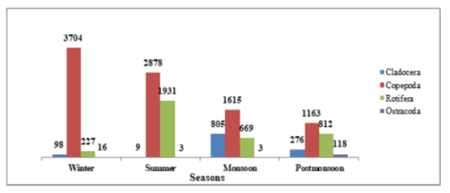


Indian Journal of Science and Technology
Year: 2021, Volume: 14, Issue: 27, Pages: 2238-2249
Original Article
Harsha D Neelgund1, Girish G Kadadevaru2*
1Department of Zoology, Karnatak Science College, Dharwad, 580001, Karnataka, India
2Department of Zoology, Karnatak University, Pavate Nagar, Dharwad, 580003, Karnataka,
India
*Corresponding Author
Email: [email protected]
Received Date:21 February 2021, Accepted Date:30 March 2021, Published Date:31 July 2021
Objectives: A study on seasonal variation in zooplankton community was undertaken to evaluate the present status of water quality at Kadasgatti minor irrigation tank (MIT) located in the northern transitional zone of Belagavi district. Methods and Statistical Analysis: Water samples were collected from January 2017 to December 2017. Physico-chemical parameters and qualitative and quantitative analysis of zooplankton were carried out. Pearson correlation was calculated using SPSS, IBM Version 21 software to find out interrelationships between water quality and zooplankton groups. Findings: A total of 52 species of zooplanktons were recorded during the study period with a total zooplankton abundance of 14327 individuals with a relative abundance of 35.42%. Rotifera was the dominant group with 27 species, followed by Cladocera, Copepoda and Ostracoda. The highest zooplankton abundance was observed in summer while minimum in post-monsoon season. Copepoda was highest abundant group during the entire study period with its maximum abundance during winter and gradually declined and reached to its minimum in post-monsoon. The presence of eutrophic indicator species like Brachionus calyciflorus, Brachionus angularis, Filina longiseta suggests eutrophication of the tank. Novelty: The study provides baseline data on the present status of the water body indicating that, anthropogenic activities, agricultural runoff are the main cause of eutrophication. Sustainable and holistic conservational strategies have to be adopted to protect the water body.
Keywords: Cladocera; Copepoda; Eutrophication; Rotifera; Seasonal variation; Zooplankton abundance
© 2021 Neelgund & Kadadevaru. This is an open-access article distributed under the terms of the Creative Commons Attribution License, which permits unrestricted use, distribution, and reproduction in any medium, provided the original author and source are credited. Published By Indian Society for Education and Environment (iSee)
Subscribe now for latest articles and news.